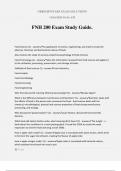©BRIGHTSTARS EXAM SOLUTIONS
11/16/2024 10:16 AM
FNH 200 Exam Study Guide.
Food Science (1) - answer✔The application of science, engineering, and math to study the
physical, chemical, and biochemical nature of foods.
Also involves the study of sensory properties (psychology of food choices).
Food Technology (1) - answer✔Takes the information received from food science and applies it
to the utilization, processing, preservation, and storage of foods.
Subfields of food science (1) - answer✔Food chemistry
Food analysis
Food microbiology
Food processing
Food engineering
Who first discovered 'canning' (thermal processing)? (1) - answer✔Nicolas Appert
What is the difference between Food Science and Nutrition? (1) - answer✔Nutrition: deals with
the effects of food in the person who consumes the food - food science deals with the
chemical, microbiological, physical and sensory properties of food during manufacture,
processing, and storage.
Who discovered 'pasteurization'? (1) - answer✔Louis Pasteur, discovered that heat kills
bacteria.
What book did Upton Sinclair write, what meaning did it have? (1) - answer✔'The Jungle' - a
book about the conditions in a meat packing plant. Forced the USDA to create the meat
inspection act and the food and drug act (of 1906).
How is apple cider made? (1) - answer✔Apple juice is inoculated with yeast strains, which work
to ferment the sugar into ethanol, creating the flavour of apple cider.
How is apple vinegar made? (1) - answer✔Apple cider is inoculated with bacterial culture,
which oxidizes the ethanol into acetic acid.
1|Page
, ©BRIGHTSTARS EXAM SOLUTIONS
11/16/2024 10:16 AM
What is pectin? (1) - answer✔Can be made from apple solids; it is a carbohydrate used as a
gelling agent.
Define Food. (2) - answer✔A mixture of chemical compounds arranged in specific organizations
that give rise to particular chemical, physical, and sensory properties.
What is a 'colloidal dispersion'? (2) - answer✔Particles of one substance are dispersed in
another substance, without dissolving.
What are the two phases of colloidal dispersion? (2) - answer✔Dispersed phase: substance
dispersed in another.
Continuous phase: surrounds the dispersed phase.
What is a 'sol'? (2) - answer✔Solid dispersed in liquid.
Ex: starches, proteins.
What is an 'emulsion'? (2) - answer✔Liquid dispersed in liquid (oil in water).
Ex: milk, mayo.
What is a 'solid emulsion'? (2) - answer✔Liquid dispersed in solid (water in oil).
Ex: margarine, butter.
What is a 'gel'? (2) - answer✔Liquid dispersed in solid (water held in polysaccharides or
proteins).
Ex: starches, pectin, gelatin.
What is a 'foam'? (2) - answer✔Gas dispersed in liquid.
Ex:whipped egg whites, whipped cake frosting.
What is a 'solid foam'? (2) - answer✔Gas dispersed in solid.
Ex: meringue, ice cream, bread.
What are the major food components? (2) - answer✔Carbohydrates, fats, proteins, water.
What are the minor food components? (2) - answer✔Organic acid, pigments, aroma
compounds, vitamins, minerals
Carbohydrates? (2) - answer✔Bodys main source of energy.
- Comes in the form of sugars and starches.
2|Page
, ©BRIGHTSTARS EXAM SOLUTIONS
11/16/2024 10:16 AM
- Should contribute about 50% of daily caloric intake.
- Should consume complex carbs rather than simple sugars.
- Contributes 4 Cal of metabolic energy per gram.
What are 'monosaccharides' and what are the different types? (2) - answer✔Glucose, Fructose,
and Galactose.
-Referred to as 'simple sugars; because of their ability to give a sweet sensation.
Glucose: 70-80 sweetness
Fructose: 140 sweetness - produces 4 Cal of metabolized energy (same amount as lactose, but
fructose is 7X sweeter).
Galactose: 60 sweetness
** Sweetness has no relation to caloric contribution
What are some functional properties of 'simple sugars'? (2) - answer✔- sweetness is
determined by structure and interaction with tongue sensory receptors.
- produce body and mouth feel when they affect viscosity.
- readily soluble in water because they contain hydroxyl groups.
- solubility of sugars increases as temperature increases.
- caramelize when exposed to high temperatures.
- reducing sugars react with proteins to produce flavours.
What are 'dissaccharides'? (2) - answer✔Disaccharides: formed by the union of two
monosaccharides (can be split into monos by enzymes or by boiling w/ dilute acid).
-most important disaccharides: sucrose, maltose, lactose.
What are the differences between 'Sucrose, Maltose, and Lactose'? (2) - answer✔Sucrose: table
sugar - obtained from sugar cane or sugar beet.
- Formed from glucose + fructose.
Maltose:
- 2 glucose units linked together.
3|Page




